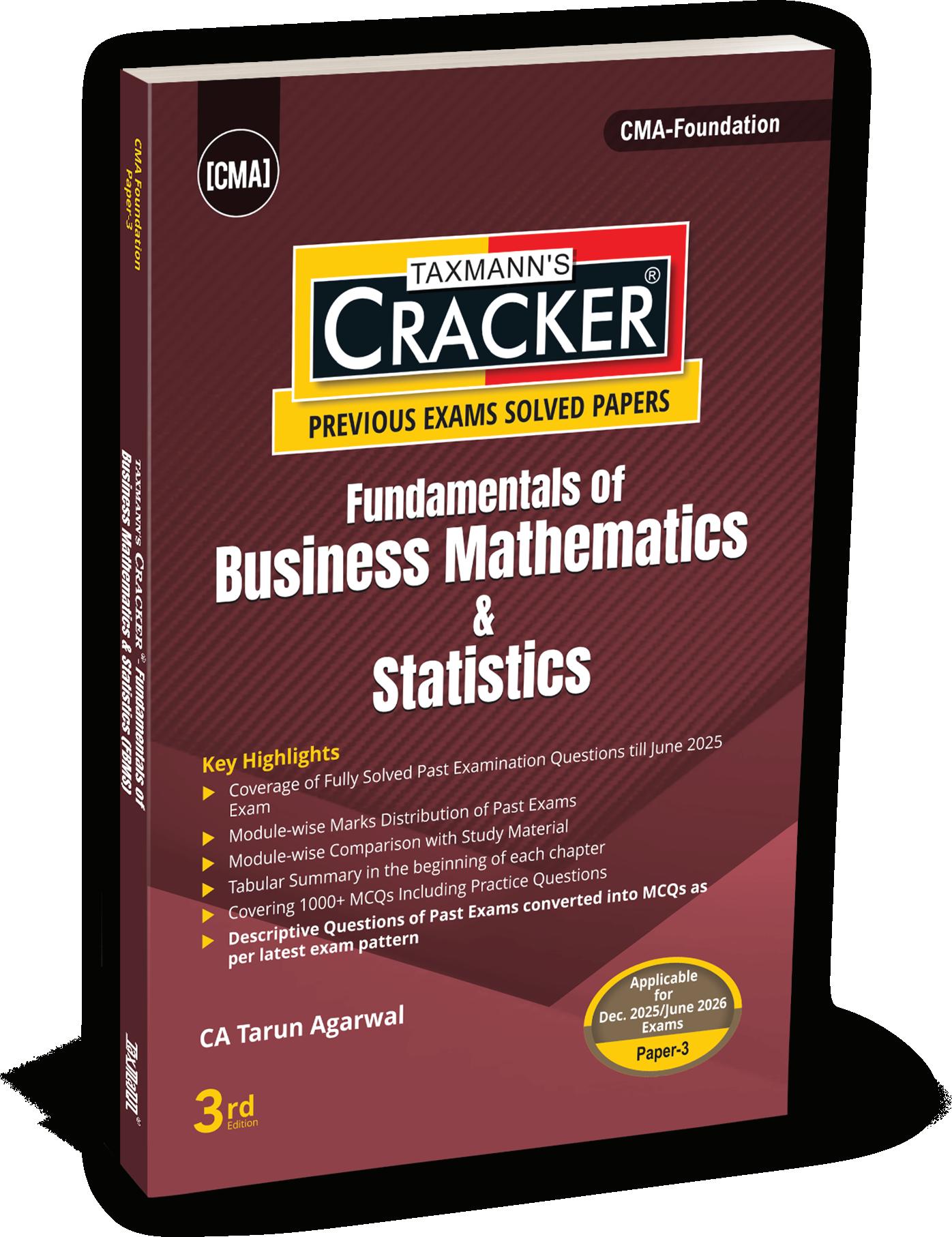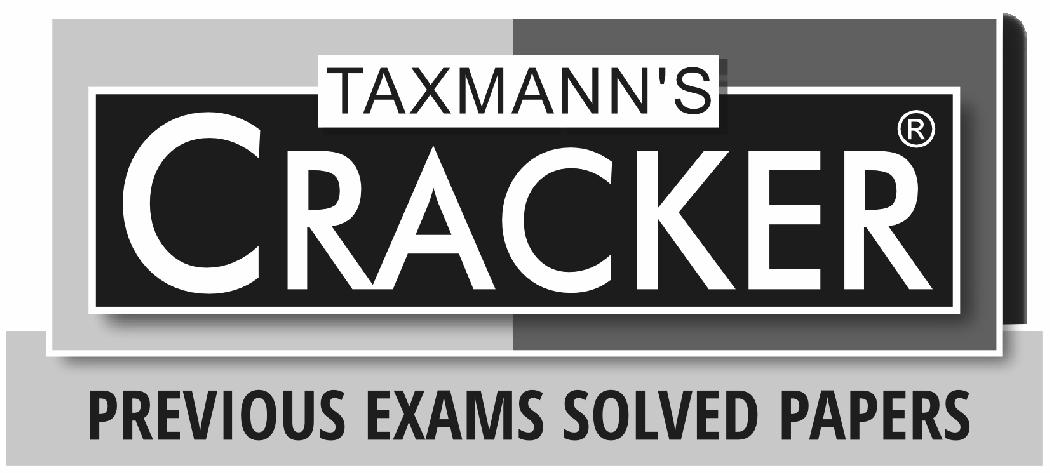MEAN, MEDIAN, MODE, MEAN DEVIATION
CHAPTER
IMPORTANT CONCEPTS
Objectives of Averaging:
There are two main objectives of the study of averages:
(i) To get one single value that describes the characteristic of the entire data. Measures of central value, can be looked into as condensing the mass of data to one single value which, enable us to get an idea of the entire data. Thus, one value can represent thousands, lakhs and even millions of values.
(ii) To facilitate comparison. By reducing the mass of data to one single gure, compare various sets of data. Comparison can be made either at a point of time or over a period of time.
Characteristics of a Good Average:
Since an average is a single value representing a group of values, it is desirable that such a value satis es the following properties:
(i) It should be easy to understand. Since statistical methods are designed to simplify complexity, it is desirable that an average be such that it can be readily understood; otherwise, its use is bound to be very limited.
(ii) It should be simple to compute. Not only an average should be easy to understand but also it should be simple to compute so that it can be used widely. However, though ease of computation is desirable, it should not be sought at the expense of other advantages, i.e., if in the interest of greater accuracy, use of a more dif cult average is desirable one should prefer that.
(iii) It should be based on all the observations. The average should depend upon each and every observation so that if any of the observation is dropped average itself is altered.
(iv) It should be rigidly de ned. An average should be properly de ned so that it has one and only one interpretation. It should preferably be de ned by an algebraic formula so that if different people compute the average from the same gures they all get the same answer.
144 MODULE 5: MEASURES OF CENTRAL TENDENCY AND DISPERSION
(v) It should be capable of further algebraic treatment. We should prefer to have an average that could be used for further statistical computations. For example, if we are given separately the gures of average income and number of employees of two or more factories we should be able to compute the combined average.
(
vi) It should have sampling stability. We should prefer to get a value which has what the statisticians call ‘sampling stability’. This means that if we pick 10 different groups of college students, and compute the average of each group, we should expect to get approximately the same values. It does not mean, however, that there can be no difference in the value of different samples. There may be some difference but those averages in which this difference, technically called sampling uctuation, is less are considered better than those in which this difference is more.
(vii) It should not be unduly affected by the presence of extreme values. If one or two very small or very large observations unduly affect the average, i.e., either increase its value or reduce its value, the average cannot be really considered as typical representative of the entire set of data. In other words, extremes may distort the average and reduce its usefulness.
ARITHMETIC MEAN:
A.M is denoted by x Bar. It is a mathematical measurement.
Properties of Arithmetic Mean:
(i) The sum of the deviations of the terms from the Actual mean is always zero.
(ii) The sum of the squared deviations of the items from arithmetic mean is minimum i.e. less than the sum of the squared deviations of the items from any other value.
(iii) If we have arithmetic mean and the number of items of two or more than two groups, we can calculate the combined average of groups.
(iv) If the terms of a series are increased, decreased, multiplied or divided by some constant, the mean will also be increased, decreased, multiplied or divided by the same constant.
(v) The standard error of the arithmetic mean is less than that of any other measure of central tendency.
Merits of A.M:
(i) Different interpretation by different persons not possible as AM is rigidly de ned
(ii) Easy to understand
(iii) It takes all values in consideration
(iv) It lends itself easily to further mathematical treatment
Demerits of A.M:
(i) It cannot be determined by inspection nor can it be located graphically
(ii) It is affected very much by extreme values. Average of 1, 2 & 3 is 2 but average of 1, 2, 33 is extremely affected by presence of 33 and the result is 12
(iii) It cannot be calculated if the distribution has open ended classes
CH. 1 : MEAN, MEDIAN, MODE, MEAN DEVIATION
GEOMETRIC MEAN (g):
The geometric mean is obtained by multiplying the values of the items together and then taking it to its root corresponding to the number of items. The Geometric mean is relative value and is dependent on all items.
The geometric mean is never larger than the arithmetic mean. It is rare that it may be equal to the arithmetic mean. The Geometric mean of the products of corresponding items is two series is equal to product of their geometric means.
Merits of G.M:
(i) Different interpretation by different persons not possible as GM is rigidly de ned.
(ii) It takes all value in consideration.
(iii) Unlike A.M, it is not affected much by the presence of extremely small or large values.
(iv) It lends itself easily to further mathematical treatment.
Demerits of G.M:
(i) It is dif cult to understand
(ii) It is dif cult to calculate particularly when the items are very large or when there is graphical data
(iii) It becomes imaginary if any of the observations is negative and GM is zero if any of the observation is zero
HARMONIC MEAN:
Harmonic mean is the reciprocal of the arithmetic mean
Merits of H.M:
(i) Different interpretation by different persons not possible as HM is rigidly de ned.
(ii) It takes all value in consideration.
(iii) It is most suitable average when it is desired to give greater weight to smaller observations and less weight to the larger ones.
(iv) It lends itself easily to further mathematical treatment.
Demerits of H.M:
(i) It is dif cult to understand.
(ii) It is dif cult to compute.
(iii) It is only a summary gure and may not be the actual item in the series.
Relationship among the different Averages:
In any distribution where the original items differ in size, then either the values of A.M > G.M > H.M (or) H.M < G.M < A.M. In case all items are identical then A.M. = G.M = H.M
146 MODULE 5: MEASURES OF CENTRAL TENDENCY AND DISPERSION
MEDIAN AND OTHER POSITIONAL MEASURES:
Median is denoted by Md. It is a positional measurement. Median divides a series into two equal parts. i.e., the middle most item is called median.
Median divides the distribution into two equal parts.
Quartile: Divides the distribution into 4 equal parts
Decile: Divides the distribution into 10 equal parts
Percentile: Divides the distribution into 100 equal parts
Merits of Median:
(i) It is not at all affected by the items on the extremes.
(ii) It can be computed for the distributions which have open ended classes.
(iii) The value of the median can be located graphically.
(iv) The median is centrally located. The absolute sum of the deviations of the individual values from the median is always the minimum.
Demerits of Median:
(i) In case of an even number of observations, median cannot be determined exactly.
(ii) It does not lend itself to algebraic treatment in a satisfactory manner
(iii) It is unsuitable if it is desired to give greater importance to large or small values.
MODE:
It is denoted by ‘Mo’. Mode may be de ned as the value that occurs most frequently in a statistical distribution.
Uses of various Averages:
(
a) Arithmetic Mean: Arithmetic mean is considered to be an ideal average. It is frequently used in all the aspects of life. It possesses many mathematical properties and due to this it is of immense utility in further statistical analysis. In economic analysis arithmetic mean is used extensively to calculate average production, average wage, average cost, per capita income, exports, imports, consumption, prices etc. When different items of a series have different relative importance, then weighted arithmetic mean is used.
(b) Geometric Mean: Use of Geometric mean is important in a series having items of wide dispersion. It is used in the construction of Index Number. The averages of proportions, percentages and compound rates are computed by geometric mean. The growth of population is measured in it as population increases in geometric progression.
(c) Harmonic Mean: Harmonic mean is applied in the problems where small items must get more relative importance than the large ones. It is useful in cases where time, speed, values given in quantities, rate and prices are involved. But in practice, it has little applicability.
CH. 1 : MEAN, MEDIAN, MODE, MEAN DEVIATION
(d) Median and Partition values: Median and partition values are positional measures of central tendency. These are mainly used in the qualitative cases like honesty, intelligence, ability etc. In the distributions which are positively skewed, median is a more suitable average. These are also suitable for the problems of distribution of income, wealth, investment etc.
(e) Mode: Mode is also positional average. Its applicability to daily problems is increasing. Mode is used to calculate the ‘modal size of a collar’, modal size of shoes,’ or ‘modal size of readymade garments’ etc. It is also used in the sciences of Biology, Meteorology, Business and Industry.
IMPORTANT FORMULAS
Arithmetic Mean
1. Discrete Data:
(i) Direct Method:
X/xn = ∑
(ii) Indirect Method:
XA/dxn =+ ∑
(iii) Step Deviation Method:
XA/ i dxni=+× ∑
A = Assumed Mean
dx = x – A
dxi = (x – A)/i
2. Grouped Data:
(i) Direct Method:
X/fxn = ∑
(ii) Indirect Method
XA/fdxf =+ ∑∑
(iii) Step Deviation Method
XA/ i fdxfi =+× ∑∑
A = Assumed Mean
dx = x – A
dxi = (x – A)/i
3. Combined Mean:
1 12212 X(XX)/() nnnn =++
148 MODULE 5: MEASURES OF CENTRAL TENDENCY AND DISPERSION
4. Weighted Mean:
X = (w1 X1 + w2 2 X )/(w1 + w2)
Geometric Mean
1. Individual Series:
g = Antilog ( ) logxn / ∑
2. Discrete Series:
g = Antilog ( ) fLogxf / ∑∑
3. Continuous Series:
g = Antilog ( ) fLogmf / ∑∑
m = mid value of class interval
4. Weighted Mean:
g = Antilog ( ) wLogxw / ∑∑
5. Combined Mean:
g = Antilog [(n1 log g1 + n2 log g2)/(n1 + n2)]
Harmonic Mean
1. Ungrouped data:
H.M. ( ) nx /1/ = ∑
2. For data with Frequency:
H.M. ( ) ffx // = ∑∑
3. Weighted H.M.:
H.M. ( ) wwx // = ∑∑
Median:
1. Individual Series:
M = (N+1)/2 th Observation
2. Discrete series with frequency:
M = (N+1)/2 th Observation
N = f ∑
3. Grouped Data (less than type):
M = l + (N/2 – cf) × h/f
l = lower boundary point of median class cf = cumulative frequency of previous class
CH. 1 : MEAN, MEDIAN, MODE, MEAN DEVIATION
f = frequency of median class
h = width of the median class
4. Grouped Data (Greater than type):
M = l + (N/2 – cf) x h/f
l = upper boundary point of median class
cf = cumulative frequency of succeeding class
f = frequency of median class
h = width of the median class
Quartiles:
Q1 = (N+1)/4 th Observation
Q2 = M = 2 (N+1)/4 th Observation
Q3 = 3 (N+1)/4 th Observation
Deciles:
D1 = (N+1)/10 th Observation
D2 = 2 (N+1)/10 th Observation
Other Deciles from D3 to D9 can be calculated similarly.
Percentiles:
P1 = (N+1)/100 th Observation
P2 = 2 (N+1)/100 th Observation
Other Percentiles from P3 to P99 can be calculated similarly.
Note: Quartiles, Deciles and Percentiles for grouped data are calculated just like Median.
Mode:
1. Individual Series: Value which occurs maximum times.
2. Discrete Series: Value with highest frequency.
3. Grouped Data:
M0= l + (f0 – f1) × h/(2f0 – f1 –f2)
l = lower boundary point of modal class
fo = Frequency of Modal Class
f1 = Frequency of preceding class
f2 = Frequency of succeeding class
h = width of modal class
Relation of Mean, Median and Mode: Mean – Mode = 3 (Mean – Median)
PAST EXAMINATION QUESTIONS
THEORY QUESTIONS
Q. 1. For a shoe-maker, which one of the following measures is most suitable to decide on the shoe sizes to manufacture?
(a) Median
(b) Arithmetic mean
(c) Mode
(d) Geometric mean [June 2013]
Ans. (c) Mode
Q. 2. Rank of Kth decile is:
(
a) (n + 1)/2
(b) (n + 1)/4
(c) (n + 1)/10
(d) k(n + 1)/10 [Dec. 2014]
Ans. (d) k (n + 1)/10
Q. 3. The third quarter is known as:
(a) Lower quarter
(b) Middle quarter
(c) Upper quarter
(d) None of these [June 2015]
Ans. (c) Upper quarter
Q. 4. ________ is known as positional average.
(a) Median
(b) Mean
(
c) Mode
(d) Range [Dec. 2015]
Ans. (a) Median
Q. 5. The average discovers:
(a) Uniformity in variability
(b) Variability in uniformity of distribution
(c) Both (a) and (b)
(d) None of these [Dec. 2015]
Ans. (a) Uniformity in variability
Q. 6. Median is:
(a) Average point
(b) Mid-point
(c) Most likely point
(d) Most remote point [June 2016]
Ans. (b) Mid-point
Q. 7. Mode is the value which:
(a) Is a mid-point
(b) Occur the most likely
(c) Average of all
(d) Most remote [June 2016]
Ans. (b) Occur the most likely
Q. 8. The middle most value of a frequency distribution table is known as:
(a) Mean
(b) Median
(c) Mode
(d) Range [June 2016]
Ans. (b) Median
Q. 9. The first quarter is known as:
(a) Lower quarter
(b) Middle quarter
(c) Upper quarter
(d) None of these [June 2016]
Ans. (a) Lower quarter
Q. 10. ______ is the value of the observation having maximum frequency.
(a) Mean
(b) Median
(c) Mode
(d) Standard Deviation
Ans. (c) Mode
[June 2017] [Modified]
Q. 11. The relation between A.M., G.M. and H.M. is expressed as:
(a) A.M. > G.M. > H.M.
(b) A.M. < G.M. < H.M.
(c) A.M. = G.M. = H.M.
(d) Any of these
[Dec. 2017] [Modified]
Ans. (a) A.M. > G.M. > H.M.
Q. 12. Median is the value of a variable which divides the whole statistical data into ____ equal parts.
(a) Four
(b) Ten
(
c) Hundred
(d) Two
[June 2018] [Modified] [Dec. 2019] [Modified]
Ans. (d) Two
Q. 13. For a frequency distribution
Median (Q2), 5th Decile (D5) and ____ Percentile have the same value.
(a) 25th
(b) 50th
(c) 75th
(d) None of these [June 2018] [Modified] [Dec. 2019] [Modified]
Ans. (b) 50th
Q. 14. Empirical relation between mean, median and mode is expressed as Mean - Mode =
(a) 3 (Mean – Median)
(b) 3 (Median – Mean)
(c) 3 (Mean – Mode)
(d) 3 (Mode – Mean) [June 2018] [Modified]
Ans. (a) 3 (Mean – Median)
Q. 15. Harmonic mean of a set of observations is the reciprocal of the _______ of the reciprocal values of the observations.
(a) Mode
(b) Median
(c) Geometric Mean
(d) Arithmetic Mean [June 2019] [Modified]
Ans. (d) Arithmetic Mean
Q. 16. The measure of central tendency of a statistical data which takes into account all the data
(a) Median
(b) Mean
(c) Mode
(d) Range [Dec. 2019] [Dec. 2022]
Ans. (b) Mean
Q. 17. The cumulative frequency table is required to find out which of the following?
(a) Mean
(b) Median
(c) Mode
(d) Range [June 2024]
Ans. (b) Median
®
152 MODULE 5: MEASURES OF CENTRAL TENDENCY AND DISPERSION
NUMERICAL QUESTIONS
Q. 1. The algebraic sum of deviations of 10 observations from the constant C is –14 and the A.M. of the observations is 7.6. The value of C is:
(a) 8
(b) 6
(c) 9
(d) 5 [June 2013]
Ans. (c) 9
Working Note:
Arithmetic Mean dnC/=+ ∑
7.6 = C + –14/10
7.6 = C –1.4
C = 9
Q. 2. If the H.M. of 4, x and 6 be 6, the value of x is:
(a) 8
(b) 12
(c) 10
(d) 6
Ans. (b) 12
Working Note:
H.M. = 3/(1/4 + 1/x + 1/6)
6 = 3/[(3 + 2)/12 + 1/x]
5/12 + 1/x = 1/2
1/x = 1/2 – 5/12
1/x = 1/12
x = 12
[June 2013]
Working Note:
Let, the numbers be x and y
A.M. = (x + y)/2
10 = (x + y)/2
x + y = 20
x = 20 – y [Equation 1]
G.M. = (xy)1/2
6 = (xy)1/2
36 = xy [Equation 2]
Inserting Equation 1 in 2 We get,
(20 – y) y = 36
20y – y2 = 36
y2 – 20y + 36 = 0
y2 – 18y – 2y + 36 = 0
y (y – 18) – 2 (y – 18) = 0
(y – 2) (y – 18) = 0
y – 2 = 0
y = 2
And
y – 18 = 0
y = 18
So, the numbers are 2 and 18
Q. 4. Heights (in cm) of 8 boys are:
70, 74, 70, 73, 72, 70, 74 and 70. The median is:
(a) 70 cm
(b) 71 cm
(c) 72 cm
Q.3 A.M. and G.M. of two numbers are 10 and 6 respectively. The numbers are:
(a) 2 and 18
(b) 3 and 17
(c) 4 and 9
(d) None of the above [June 2013]
Ans. (a) 2 and 18
(d) None of the above [June 2013]
Ans. (b) 71 cm
Working Note:
Arranging the values in ascending order we get, 70, 70, 70, 70, 72, 73, 74, 74
Median = (70 + 72)/2 = 71 cm









